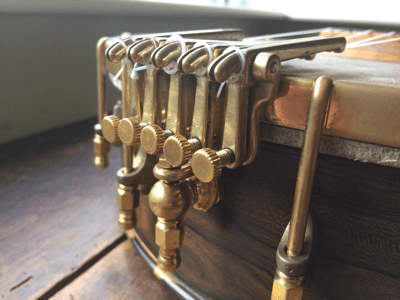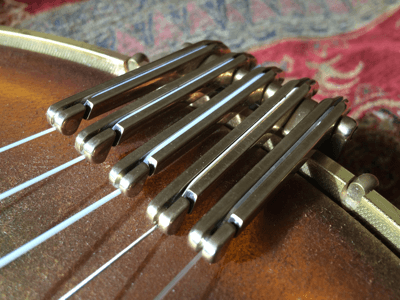Oettinger Tailpiece Set Up
Adjusting The Fingers
Reproduced here with the kind permission of the original author, Frank Geiger, is probably the clearest explanation I have found of how to adjust the fingers of an Oettinger tailpiece. Frank wrote this regarding his four string banjos but the technique is true for all Oettinger tailpieces. Frank is a retired 26-year Solo Tenor Banjo Entertainer based in Atlanta, Georgia, U.S.A. He is also the Owner/Inventor of Geiger Acoustic Devices which is well worth checking out.
"The effectiveness of the Oettinger tailpiece probably varies with tuning but it often greatly improves the sound of a tenor banjo because the tuning varies so much across the strings. Traditional tenor banjo tuning is CGDA, lowest to highest. Because the high pitched A string is under a great deal of tension it exerts a large downward force on the bridge. This downward force on the bridge is less for the lower pitched D string, even less for the G, and lowest for the low C string.
Please forgive this simple analogy but it helped me: If you think of the bridge as a little boat floating on the banjo head, each of these strings is like a passenger in the boat and the passengers differ greatly in weights. The boat is very poorly trimmed in the water (on the banjo head) because the heaviest passenger is on one end and the lightest passenger is on the other end. So you can imagine what the boat does when the passengers start to jiggle in their seats when the banjo is played!
The Oettinger allows the banjo player to vary the downward force of each string - in effect change the weights of the passengers in the analogy. When an arm of the Oettinger is raised, the downward force on the bridge is lowered. You can do this with almost any tail piece by canting it to one side, but this is a crude adjustment. What the Oettinger does beyond this is to enable you to optimally "trim" the bridge on the head by listening to the sound of the banjo as each of the arms is raised or lowered.
You can shorten this process by pushing down on the Oettinger 'finger' slowly while plucking the string and you will hear the best sound from that string when the 'finger' is the right distance from the head. Try to hold that position and tighten the Oettinger adjustment screw with the other hand. This gives a good starting point if you do this for each string. But one time across the 'fingers' is not enough.
I use an Oettinger tailpiece on my Gibson tenor and Paramount tenors but not my Irish tenor (tuned low GDAE). I suspect that the payoff is not as great for plectrum banjos and five string banjos because the downward forces on the bridge are not as great or as poorly distributed as they are on a tenor with traditional tuning. It makes a huge difference on my Gibson."
~ Frank Geiger
 Most people seem to attach the strings to the tailpiece as shown in the picture to the left. The problem with this method is the loop can pull over to one side and the string pulls out of the groove that runs down the middle of each finger.
Most people seem to attach the strings to the tailpiece as shown in the picture to the left. The problem with this method is the loop can pull over to one side and the string pulls out of the groove that runs down the middle of each finger.
 I tie a small looped Bowlin Knot and loop that over the 'hook' with the actual knot beneath the hook, then I pass the string back through the loop and along the finger groove. This ensures that the string runs down the whole length of the finger. This method may only work for nylon strings, I've never tried it with steel strings.
I tie a small looped Bowlin Knot and loop that over the 'hook' with the actual knot beneath the hook, then I pass the string back through the loop and along the finger groove. This ensures that the string runs down the whole length of the finger. This method may only work for nylon strings, I've never tried it with steel strings.
 The usual adjustment of the Oettinger tailpiece is with the treble strings having reduced downward pressure and the bass strings having increased downward pressure. On this 5 String Oettinger you can see that the 1st string has less downward pressure than the fourth. Banjo sound is very subjective and the Oettinger makes getting the sound you want achievable.
The usual adjustment of the Oettinger tailpiece is with the treble strings having reduced downward pressure and the bass strings having increased downward pressure. On this 5 String Oettinger you can see that the 1st string has less downward pressure than the fourth. Banjo sound is very subjective and the Oettinger makes getting the sound you want achievable.
